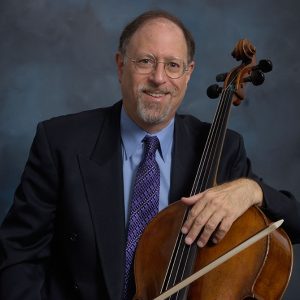
The Joy of Feuillard – A Sequential Approach to Teaching Bow Technique (Part 19 – Feuillard No. 34 – Variations #6-12)
Robert Jesselson
Last week’s Blog dealt with some Arc and Figure Eight bowing figures. Today’s blog will continue the Feuillard variations in No. 34 with some Wave and Circle bowing figures, and add some detaché motions to the mix. The string crossings here should happen with the upper arm, and the detaché stroke is with the lower arm.
Variations #6 and #7:
In these variations we have both horizontal and vertical motions. The vertical motion is the string crossing – in this case going from the D-string to the A-string with the upper arm. The horizontal motion is the detaché with the lower arm. The important thing is that when there are two different motions going on simultaneously (vertical and horizontal) we should use two different part of the arm.
For example, in the third movement of the Saint-Saens concerto we have sautillé strokes and string crossings happening at the same time. The sautillé (horizontal motion) happens with the wrist (or for some people with the lower arm) and the string crossing (vertical motion) should happen with the upper arm.

We will see much more of this issue in Variations #9-#22.
One has to be particularly vigilant about using the upper arm for the string crossings at the tip. There is a temptation to use the lower arm if one is not careful, but that would produce a lot of tension in the elbow joint, and could be a source of a bigger problem: tendonitis.
Variation #8:

This variation is a Wave. Eventually waves will happen with either the fingers, wrist or upper arm – depending on the tempo, the dynamics, and the part of the bow. We will explore this further in the next Blog by doing exercises for each part of the arm. However in Variation #8 the tempo is not too fast, and we are using the whole bow with a big sound. So we should use the upper arm for this wave.
It is important for students to be aware of using the right part of the arm for the string crossings at this point in their development and ingrain the correct kinesthesiology into their body. Otherwise the bad habit of using the lower arm for string crossings will remain and some years later they may suddenly have pain or “tennis elbow”. I believe in preventative medicine!
Variation #9:

The string crossing in this variation is a Circle. If we play just the first two notes (not the repeated notes) and repeat them one can see the circular motion that is involved.
With this variation we have the first of several exercises for string crossings with the detaché stroke added. Again, it is really important for the students to understand that when we have two different motions (vertical and horizontal) two different parts of the arm move independently. In this case we are using the lower arm for the detaché and the upper arm for the string crossing.
Variations #10, #11, and #12:



The next three variations continue with this work, adding bow distribution to the mix. A lot of the issues here involve coordination: which part of the arm to use, finding the right balances, and using vibrato. In Variation #11 I spoke with Tristan about the “twist” motion of the lower back and shoulders. These large muscles can help a lot with releasing tension from the fingers. In other words, if one balances on the finger that is playing, one can eliminate unnecessary tension in the other fingers. But rather than lifting the fingers that are not being used, we can use the twist motion to the upper body to move the arm from string to string. In that way the fingers that are not being used are automatically released from pushing down on the string. And as a result the hand is more relaxed and will be able to vibrate more easily. But all this involves using the right choreography.
Next week’s blog will present several exercises which isolate the wrist and the fingers. The “box” exercises work with the movement of the wrist, and the “puppet” exercises work with the fingers. After the students can do these exercises easily, they need to do the bowing figures with just the wrist and then with just the fingers in order to have the flexibility to do the wave motion and fast string crossings. We will explore all this next week.
*If you have questions or comments about The Joy of Feuillard, Dr. Robert Jesselson can be reached directly at rjesselson@mozart.sc.edu.
Subjects: Repertoire, Technique


